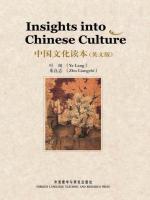Chinese Culture
In the vast sea of cultural literature, “Understanding Chinese Culture” stands out as a remarkable bridge connecting Chinese traditions with the world. This book, penned by a team of erudite scholars, offers readers, both Chinese and international, a comprehensive yet engaging exploration of China’s rich cultural heritage.
The book kicks off with an enticing introduction that sets the stage for the cultural journey ahead. It delves into the origins and evolution of Chinese culture, tracing its roots back thousands of years. The authors adeptly weave together historical facts and vivid anecdotes, making the ancient past accessible and relatable. As I turned each page, I felt as though I was stepping back in time, witnessing the rise and fall of dynasties and the birth of philosophical thoughts that continue to shape China today.
One of the most captivating aspects of the book is its in-depth examination of various facets of Chinese culture. It explores the delicate brushstrokes of traditional Chinese painting, the harmonious melodies of classical music, and the profound meanings embedded in Chinese literature. The authors take great care to explain the symbolism and techniques behind these art forms, offering readers a deeper appreciation of their beauty and significance. For instance, the chapter on Chinese painting not only describes the different styles and subjects but also delves into the spiritual and philosophical ideas that artists sought to convey through their works.
The book also sheds light on Chinese philosophy and religion, which serve as the backbone of Chinese culture. It provides clear and concise explanations of Confucianism, Taoism, and Buddhism, highlighting their core teachings and their influence on Chinese society and values. Through vivid examples and thought-provoking discussions, the authors demonstrate how these philosophical systems have shaped Chinese ethics, family structures, and social norms. This section was particularly enlightening for me, as it helped me understand the underlying principles that guide Chinese behavior and thought patterns.
Furthermore, the book does an excellent job of introducing readers to Chinese folk customs and traditions. It describes the vibrant celebrations of the Chinese New Year, the Dragon Boat Festival, and the Mid-Autumn Festival, among others. The authors paint a vivid picture of the rituals, foods, and decorations associated with these festivals, allowing readers to experience the joy and warmth of Chinese cultural celebrations. I found myself eagerly turning the pages, wanting to learn more about each custom and tradition.
What sets this book apart from others in the same genre is its approachable style and rich illustrative content. The authors avoid overly academic language, making the book accessible to a wide range of readers. The inclusion of numerous images, maps, and diagrams further enhances the reading experience. These visual elements not only add aesthetic appeal but also help readers better visualize and understand the concepts discussed in the text.
In terms of structure, the book is well-organized, with each chapter focusing on a specific theme and building upon the previous one. This logical flow allows readers to gradually deepen their understanding of Chinese culture. Additionally, the book features a comprehensive index and bibliography, which are invaluable for readers who wish to explore certain topics in greater depth.
However, the book is not without its minor shortcomings. While it covers a broad spectrum of cultural topics, some areas could have been explored in more depth. For example, the discussion on modern Chinese culture and its intersection with traditional values is somewhat brief. A more extensive examination of this aspect would have provided a more complete picture of Chinese culture in today’s globalized world.
Despite this minor limitation, “Understanding Chinese Culture” is an outstanding resource for anyone interested in gaining insight into Chinese culture. It succeeds in presenting the complexities and nuances of Chinese traditions in a clear and engaging manner. Whether you are a scholar, a student, or simply a curious reader, this book offers a wealth of knowledge and inspiration.
In conclusion, “Understanding Chinese Culture” is more than just a book; it is a gateway to a world of beauty, wisdom, and tradition. It invites readers to embark on a journey of discovery and appreciation, fostering a deeper understanding and respect for Chinese culture. As the world becomes increasingly interconnected, books like this play a crucial role in bridging cultural gaps and promoting cross-cultural dialogue. I wholeheartedly recommend this book to all those who wish to explore the fascinating tapestry of Chinese culture and gain a greater appreciation for its enduring charm and significance.



 京公网安备 11010802032529号
京公网安备 11010802032529号